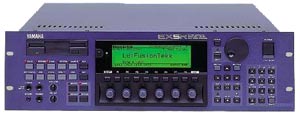Yamaha EX5R (Various)

I remember when the Yamaha EX5, and the rack EX5R, were first released. The synth generated quite a bit of buzz on the internet prior to it's release. In fact, to my memory, it was the first sysnth that really was a product of the internet age and all it's up's and down's. In the internet age, products seem to exist, apart from any real utility, as spec sheets for people to argue over. This spec sheet mentality, derived probably from the beige box PC parts world, tends to focus on products as nothing more than a list of bullet points, when it truth those bullet points may not really convey the quality of the product.
Recently this has been the case most obviously with the iPhone. When announced, it created a lot of positive press, but a few naysayers, accompianied by competing phone companies, pointed out that there were already products that had the same features--email, web, music player, video player, touch screen--as the iPhone. Of course this spec sheet completely missed the point, as it was how the features worked and tied together that made the product.
What does this have to do with the EX5? At the time of it's realease, Yamaha had published a spec sheet for the synth--128 note polyphony, AWM2, AN synthesis, VL synthesis, sampling, etc.-- that had stoked a lot of interest and enthusiam--with no one having heard a note. To my experience, this was the first synthesizer that had been sold on specs like that, but the end result was that thee was a lot of dissapointment when the machine shipped, not because of lack of sound quality, but because of some major flaws the limited the machine. Over time, some of those problems were fixed, but others were not, and Yamaha moved on to their next workstations.
Make no mistake, this is a great sounding synth. It combines a powerful sample based synthesizer with a DSP capable of FDSP filtering, AN analog modeling, and VL acoustic modeling. To my knowledge it was the first mainstream synth to package multiple unrelated synthesis systems into the same box. In some ways, it is a good do-anything workstation. But it's at that point that the flaws come in. The sample playback engine has plenty of power--126 notes of polyphony--but the DSP is very limited, and can only do one thing at a time. If you have a VL voice on one MIDI channel, you cant put a AN voice on another or an FDSP voice. Pick one, with one note of polyphony. The EX5 has a sampler to allow recording your own instrument samples, but the SCSI card is not standard, and its implementation is painfully slow--rivalling floppy speeds.
These shortcomings make it hard to use however you like, which limits it as a simgle do everything synth--a Kurzweil K-Series synth is better suited to that. But for an entra synth to add depth and color, it works great. Also, today, they can be had pretty cheaply.
x y . c x